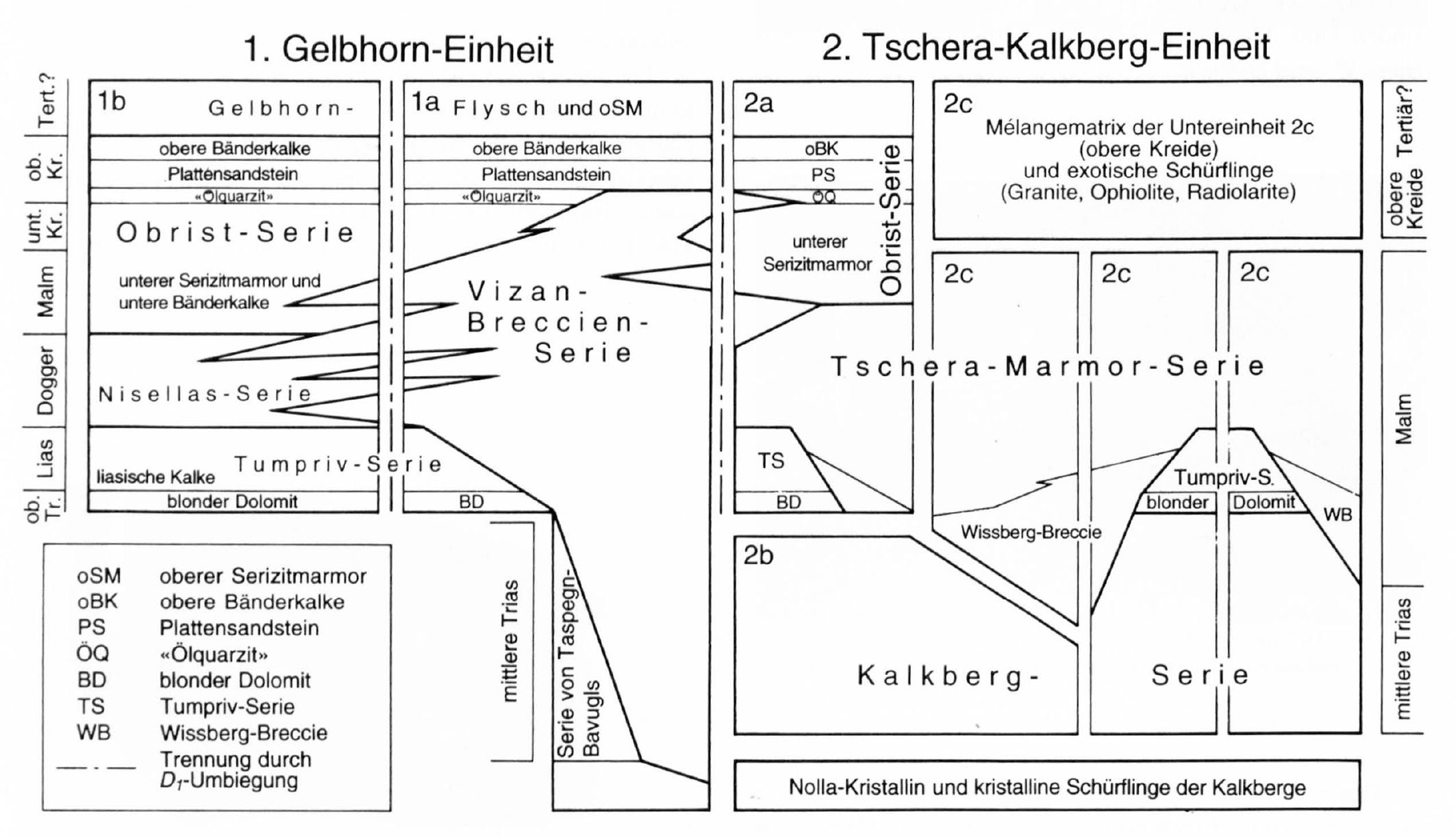Schams-Deckenkomplex
Back to Schams nappe complexRepresentation and status
- Index
- Sch
- Color CMYK
- (0%,1%,2%,5%)
- Color RGB
- R: 241 G: 239 B: 237
- Rank
- nappe complex
- Validity
- Unit is in Use
- Status
- valid
- Status discussion
-
Muntogna/Tgea da Schons, Valle di Schams, Vallée de Schams
Nomenclature
- Deutsch
- Schams-Deckenkomplex
- Français
- Complexe de nappes du Schams
- Italiano
- Complesso di falde dello Schams
- English
- Schams Nappe Complex
- Origin of the Name
-
Schams = Val Schons (GR), Hinterrheintal
- Historical Variants
-
Schamser Decken (Zyndel 1912, Wyss & Isler 2007), Schamserdecken (Wilhelm 1933), Falde dello Schams (Sciesa 1991), nappes du Schams (Mayerat Demarne 1994), Schams Nappe Complex (TK500 / Gouffon et al. 2024)
- Nomenclatorial Remarks
-
cf. Schreurs 1990, Schmid et al. 1990
Description
- Description
-
Komplex verfaltetes Deckenkomplex, das in Graubünden zwischen den nordpenninischen Bündnerschiefern und den ophiolithführenden südpenninischen Einheiten liegt und um die Front der Tambo- und Suretta-Decken herumgewickelt ist.
Age
- Age at top
-
- Eocene
- Age at base
-
- Carboniferous
Geography
- Geographical extent
- Südliche Fortsetzung zwischen die Tamboalp und der Einshorn (Mayerat Demarne 1994).
Palaenography and tectonic
- Paleogeography
-
Briançonnais Terrane
:
microcontinent briançonnais
- Tectonic unit (resp. main category)
- Kind of protolith
-
- tectonic
References
- Definition
-
(2024) :
Tectonic Map of Switzerland 1:500000, Explanatory notes. Federal Office of Topography swisstopo, Wabern
p.75: The Schams Nappe Complex comprises a set of small nappes, composed of sedimentary sequences exhibiting large facies variations and rich in sedimentary syn-rift breccias of Middle Jurassic to Early Cretaceous age, indicating contemporaneous extension and sinistral strike-slip (Rück 1995). The mid-Cretaceous to Cenozoic post-rift sediments are very similar to those found in the Falknis Nappe. After its emplacement, this nappe complex was folded around the Tambo-Suretta pair during the Niemet-Beverin post-nappe folding (Schreurs 1995). The fact that the Schams nappes are folded around a locally near-isoclinal fold has long raised the question about the origin of this nappe complex either below the Tambo Nappe or on top of the Suretta Nappe (Schmid et al. 1990). Structural criteria clearly show that the Schams Nappe Complex has to be rooted below the Tambo Nappe (Schreurs et al. 1995). Retrodeformation suggests that the Schams nappes formerly occupied an area north of the depositional area of the Tambo and Suretta Mesozoic (Schmid et al. 1997). This is supported by facies arguments indicating that sediments in the originally northernmost paleogeographical position (now forming the Gelbhorn Nappe) suggest N-directed shedding of syn-rift breccias, and by the Subbriançonnais-type facies of the Triassic strata (Rück 1995). The Schams Nappe Complex also contains different mélanges: to the west, in the lower limb of the Niemet-Beverin Backfold, the Knorren Mélange is in contact with the Tambo Nappe, while the Areua-Bruschghorn Mélange marks the boundary with the Tomül Nappe; to the east, in the upper (overturned) limb of the Niemet-Beverin Backfold, the Martegnas Mélange is in contact with the Arblatsch Flysch belonging to the Tomül Nappe (Mayerat Demarne 1994, Schreurs 1995).

